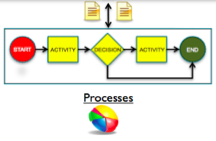by ARSALAN KHAN
The term business process is used to describe the connectivity of the various “steps” performed to achieve a certain goal. These steps are performed by information systems (e.g., calculate products sold per region), individuals (e.g., print/read reports) or a combination of both. The basis for these steps comes from policies (e.g., thou shall not eat at the computer), procedures (e.g., after you have created a report make a list of people who actually read it), governance (e.g., when information comes in or created by the organization then who and how it should be distributed) etc. These steps can be for a particular division (e.g., finance) and/or cross-functional (e.g., financial reports used by HR to make offers to potential hires). On the other hand these steps can be wasteful (e.g., a division is creating reports for an individual who is not with the organization any more).
In order to understand the complexities of the business processes that are engrained into the organization, the following questions need to be asked about your current and future business processes:
| Currently | In the Future |
|---|---|
| Who follows business processes? | Who should follow business processes? |
| What happens in business processes? | What should happen in business processes? |
| Where do business processes take place? | Where should business processes take place? |
| When do business processes happen? | When should business processes happen? |
| Why business processes happen? | Why business processes should happen? |
When you are asking the above questions across all levels of the organization, keep in mind that there is interconnectedness among the information that you are collecting even if it is not evident at first glance. During or after collection of this information, it is useful to create business process maps to show what happens and what would happen in the future. These maps should not be created just to be created but should be created to make intelligent decisions. These maps should be kept at a central place where people can easily have access to them and should be able to understand them without the need for an expert.
Another thing to be cognizant of who you talk to in the organization since depending upon who you talk to their definition of “a business process” might be different than what you are trying to understand. Yet one more term that is interchangeably used for business process is workflow. For technical folks this can also mean the business process that happen within an information system.
In conclusion, too often it is seen that organizations are struggling because of the ineffective communication and management mechanisms in place. By mapping the business processes, determining their qualitative and quantitative values, you will be able to see these gaps and make decisions that can prove to be beneficial to you as an individual and the organization as a whole.

*Reposted from KHAN’S BLOG:
https://arsalanakhan.wordpress.com/2014/05/09/5-questions-to-ask-about-your-business-processes/







